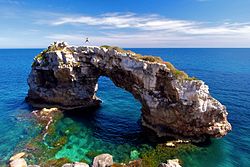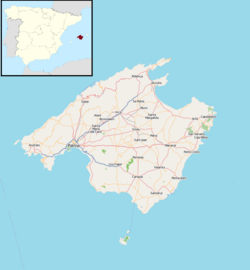
A climbing route is a path by which a climber reaches the top of a mountain, or rock/ice-covered obstacle. The details of a climbing route are recorded in a climbing guidebook and/or in an online climbing route database, and will include elements such as the type of climbing route, the difficulty grade of the route–and beta on its crux(es)–and any risk or commitment grade, the length and number of pitches of the route, and the climbing equipment needed to complete the route.

Solo climbing, or soloing, is a style of climbing in which the climber climbs a route alone, without the assistance of a belayer. By its very nature, it presents a higher degree of risk to the climber, and in some cases, is considered extremely high risk. Note that the use of the term "solo climbing" is generally separate from the action of bouldering, which is itself a form of solo climbing, but with less serious consequences in the case of a fall. The most dangerous form of solo climbing is free solo climbing, which means both climbing alone and without any form of climbing protection.

Chris Omprakash Sharma is an American rock climber who is considered one of the greatest and most influential climbers in the history of the sport. He dominated sport climbing for the decade after his 2001 ascent of Realization/Biographie, the world's first-ever redpoint of a consensus 9a+ (5.15a) graded route, and ushered in what was called a "technical evolution" in the sport. Sharma carried the mantle of "world's strongest sport climber" from Wolfgang Güllich, and passed it to Adam Ondra.
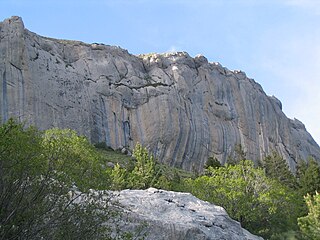
Realization, also called Biographie, is a circa 35-metre (115 ft) sport climbing route on a limestone cliff on the southern face of Céüse mountain, near Gap and Sigoyer, in France. After it was first climbed in 2001 by American climber Chris Sharma, it became the first rock climb in the world to have a consensus grade of 9a+ (5.15a). It is considered an historic and important route in rock climbing, and one of the most attempted climbs at its grade.
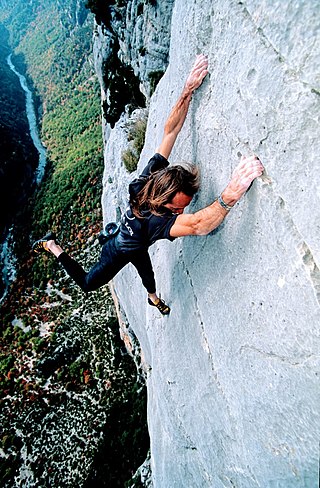
Free solo climbing, or free soloing, is a form of rock climbing where the climbers climb solo without ropes or other protective equipment, using only their climbing shoes and their climbing chalk. Free soloing is the most dangerous form of climbing, and, unlike bouldering, free soloists climb above safe heights, where a fall can be fatal. Though many climbers have free soloed climbing grades they are very comfortable on, only a tiny group free solo regularly, and at grades closer to the limit of their abilities.

Deep-water soloing (DWS), also known as psicobloc, is a form of free solo climbing where any fall should result in the climber landing safely into deep water below the route. DWS is therefore considered safer than normal free solo climbing, however, DWS brings several unique additional risks including trauma from uncontrolled high-speed water entry, injury from hitting hazards above and below the water while falling, and drowning in rough or tidal seas, and is thus considered riskier than normal bouldering.

In the history of rock climbing, the three main sub-disciplines—bouldering, single-pitch climbing, and big wall climbing—can trace their origins to late 19th-century Europe. Bouldering started in Fontainebleau, and was advanced by Pierre Allain in the 1930s, and John Gill in the 1950s. Big wall climbing started in the Dolomites, and was spread across the Alps in the 1930s by climbers such as Emilio Comici and Riccardo Cassin, and in the 1950s by Walter Bonatti, before reaching Yosemite where it was led in the 1950s to 1970s by climbers such as Royal Robbins. Single-pitch climbing started pre-1900 in both the Lake District and in Saxony, and by the late-1970s had spread widely with climbers such as Ron Fawcett (Britain), Bernd Arnold (Germany), Patrick Berhault (France), Ron Kauk and John Bachar (USA).

La Rambla is a 41-metre (135 ft) sport climb at the limestone El Pati crag in Siurana, Catalonia in Spain. Originally bolted and climbed by Alexander Huber in 1994 as a 35-metre (115 ft) route, the bolting was later extended by Dani Andrada to a 41-metre (135 ft) route, which was eventually climbed by Ramón Julián Puigblanque in 2003. While there has been debate about La Rambla's grade, there is now consensus that it meets the 9a+ (5.15a) threshold. It is an important and historic route in climbing, and is part of the coveted "9a+ trilogy" with Realization and Papichulo.
Big UP Productions is an American film production company based in New York City who are particularly known for work in the area of rock climbing. The company is led by Josh Lowell, and films include titles such as: Rampage (1999), Dosage Volume 1 (2001), Pilgrimage (2003), Dosage Volume 2 (2004), Dosage Volume 3 (2005), and King Lines (2007). Rock climbers profiled in Big UP Production films included leading names such as: Chris Sharma, Tommy Caldwell, and Tim Emmett. In 2006, Big UP Productions and Sender Films received a Sports Emmy for "Outstanding Camera Work" for their work filming American climber Chris Sharma's first ascent of deep-water soloing route Es Pontàs, in Mallorca Spain; it was part of the climbing film King Lines.
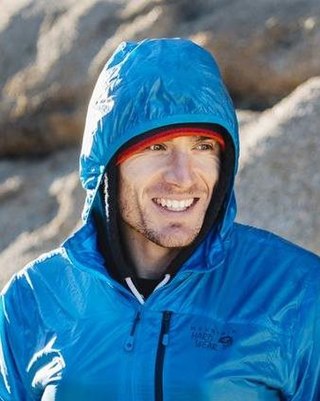
Ethan Pringle is an American rock climber with notable ascents in sport climbing, in traditional climbing, and in bouldering. He has also been active in competition climbing, winning the American national competition lead climbing championships in both youth and adult formats, and silver at the World Youth Championships.

Alexander Megos is a German rock climber specializing in sport climbing, bouldering and competition climbing. In 2013, he became the first-ever climber to onsight a 9a (5.14d) graded route. He has made the first free ascent (FFA) of some of the hardest sport climbing routes in the world, including two 9b+ (5.15c) routes, three 9b (5.15b) routes, and several boulders with a boulder 8C (V15) rating.

Jakob Schubert is an Austrian professional rock climber, specializing in competition climbing, sport climbing, and bouldering. He was four times World Champion and three times World Cup winner in lead climbing. In August 2021, he won bronze at the 2020 Summer Olympics in Tokyo. As of the end of 2022, Schubert had won the most men's IFSC gold medals of any male competition climber in history. In addition to competition climbing, Schubert is the only climber in the world to have redpointed a 9c (5.15d) graded sport climbing route and climbed a 9A (V17) graded bouldering problem.

Sachi Amma is a Japanese professional rock climber and sport climber. He won the IFSC Climbing World Cup twice, in 2012 and 2013.

Jan Hojer is a German professional rock climber specializing in sport climbing, bouldering, and competition climbing. He is known for winning one World Cup and two European Championships in competition bouldering. In May 2010, he climbed Action Directe, one of the most difficult sport climbing routes in the world. From 2013 to 2015, he sent several 8C (V15) boulder problems.

Jernej Kruder is a Slovenian rock climber who specializes in competition climbing, bouldering and sport climbing. In 2018, he won the IFSC Climbing World Cup in competition bouldering.
Sébastien Bouin, nicknamed Seb Bouin, is a French rock climber born in Draguignan. By 2022, Bouin is regarded as one of the strongest sport climbers in the world, being only the second-ever climber to establish a route graded 9c (5.15d), with DNA in 2022, and one of only a handful of climbers to create a new route at the grade of 9b+ (5.15c). Bouin is also regarded for his documentary series on the history of extreme sport climbing in France.

Jumbo Love is a very long 76-metre (249 ft) sport climbing route, on remote limestone cliffs on Clark Mountain in the Mojave Desert. Bolted by American climber Randy Leavitt in the 1990s, he invited Chris Sharma to attempt it in 2007. When Sharma completed the first free ascent on September 11, 2008, the route became the first-ever rock climb in history to have a confirmed grade of 9b (5.15b), and it remains an important route in the history of rock climbing.

Jonathan Siegrist is an American rock climber who is regarded as one of the world's most prolific extreme sport climbers, and who has redpointed, and made numerous first free ascents, of a large number of sport climbing routes at and above the grade of 9a (5.14d). Siegrist's breadth of experience at the world's most extreme sport climbing grades, means that he is often looked to for guidance regarding the grading of extreme sport routes in America. While principally known as a sport climber, he has repeated some of the world's hardest traditional climbing routes.

Es Pontàs is a 20-metre (66 ft) long limestone deep-water soloing (DWS) climbing route on the Es Pontàs sea-arch in Mallorca, Spain. After it was first free soloed in September 2006 by American climber Chris Sharma, it became graded at 9a+ (5.15a) – the world's first-ever DWS route at that grade, and one of the earliest 9a+ graded rock climbs of any type in history. Es Pontàs was credited with promoting the emerging sport of DWS, and further enhancing Sharma's reputation and legacy as a pioneer in rock climbing. Sharma's first ascent was featured in the award-winning 2007 climbing film, King Lines.
